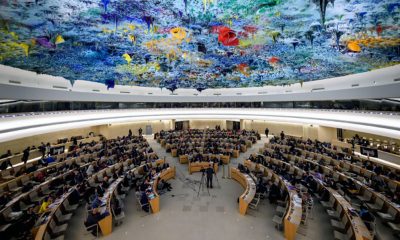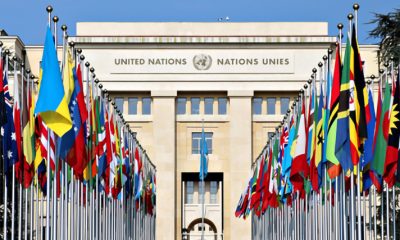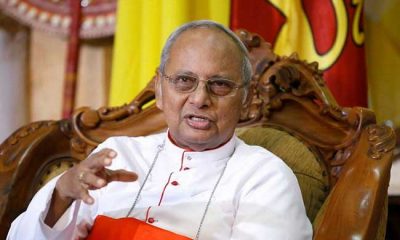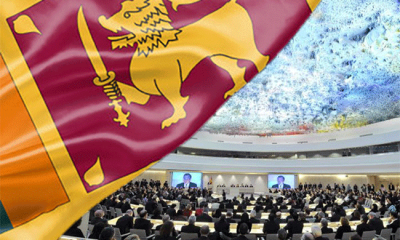Features
UNHRC’s repeated resolutions without resolution
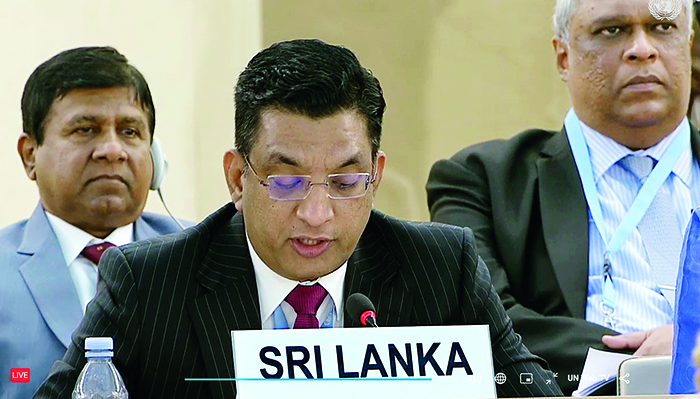
by Neville Ladduwahetty
September is the month when the UN Human Rights Council presents its latest Resolution on Sri Lanka. It is reported that the latest version has graduated from violations of human rights and international humanitarian law to include violations of “economic crimes”. Whatever the scope of the Resolution, the dogged fact remains that every sovereign country is compelled to function within the provisions of its own Constitution, because it is the fundamental law as recognized by the Vienna Convention; a fact unequivocally stated by the President and Foreign Minister of this Government, and repeated earlier by previous governments. This fundamental fact was the rationale for rejecting the former co-sponsored Resolution UNHRC 30/1. Therefore, if the UNHRC is serious about its Resolutions, it has to start with Sri Lanka’s Constitution. Incorporating provisions in Resolutions beyond the provisions of the Constitution become a meaningless and distracting exercise for all concerned, without Resolution.
Chapter III of the Constitution of Sri Lanka is titled “Fundamental Rights”. Under Fundamental Rights, there are NO provisions that address “violations of human rights and violations of international humanitarian law”, nor is there any provision for “economic crimes”. The only provision that is of relevance is under Article 13, and in particular 13 (6) on Fundamental Rights.
This Article 13 (1) states: “No person shall be held guilty of an offence on account of any act or omission which did not, at the time of such act or omission constitute such an offence, and no penalty shall be imposed for any offence more severe than the penalty in force at the time such offence was committed”.
If a person is “guilty of an offence”, the punishment for such an offence should be as contained in Sri Lanka’s Penal Code.
THE PENAL CODE
CHAPTER I
Paragraph 2 (1) of the Penal Code states: “Every person shall be liable to punishment under this Code, and not otherwise, for every act or omission contrary to the provisions thereof, of which he shall be guilty within Sri Lanka.
CHAPTER II
GENERAL EXPLANATIONS
Paragraph 5 states: “Throughout this Code every definition of an offence, every penal provision, and every illustration of every such definition or penal provision shall be understood subject to the exceptions contained in Chapter IV, “General Exceptions”, though these exceptions are not repeated in such definition, penal provision, or illustration”.
ESTABLISHING GUILT
Therefore, any person “guilty of an offence” should conform to the definition stated in the Penal Code of Sri Lanka. However, the Constitution under the second paragraph of Article 13 (6) states: “Nothing in this article shall prejudice the trial and punishment of any person for an acct or omission which, at the time when it was committed, was criminal according to the general principles of law recognized by the community of nations”.
This means that even if a person is NOT guilty of an offence under the Penal Code, he/she could be guilty of a criminal act under provisions “of law recognized by the community of nations”. The issue then resolves itself into identifying the relevant instruments that contain the “general principles of law” to establish guilt for acts that are recognized by the community of nations.
Therefore, under provisions of the Constitution a person could be found guilty of an offence either under provisions of the Penal Code or under provisions contained in instruments of law recognized by the community of nations.
INSTRUMENTS REGOGNIZED by the COMMUNITY of NATIONS
The context for determining whether an offence was committed or not should be based on the acknowledged fact that conflict was an Armed Conflict and therefore the applicable law is International Humanitarian Law; a fact acknowledged by the representatives of the LTTE to the European Court. Furthermore, since the conflict was a Non-International Armed Conflict the applicable legal framework is the Additional Protocol II of 1977. This Protocol is an extension of Common Article 3 of the Geneva Conventions. Although Sri Lanka has not formally ratified Protocol II, it is today accepted as an instrument of international customary law accepted by the community of nations.
Therefore, any questions of guilt for offences committed during the Armed Conflict should either be based on provisions of the Penal Code or procedures laid out in Article 6. “Penal prosecution” of Additional Protocol II. Part II of the Additional Protocol Paragraphs 2 (a) to (h) and 3 (a) to (c) specify what constitutes violations that ‘shall remain prohibited at any time and in any place whatsoever”.
NATIONAL LAWS COMPLEMENTTARY to INTERNATIONAL LAWS
Domestic Laws should take primacy over provisions of international law as recognized by the Rome Statute in its Preamble that states: “Emphasizing that the International Criminal Court established under the Statute shall be complementary to national criminal jurisprudence”. Endorsing the principle of complementarity, Justice A.R.B. Amerasinghe states: “The ultimate goal of international norm-setting is their full and effective implementation through domestic procedures without the need for recourse to international mechanisms. In fact, access to international mechanisms is usually limited and may be resorted to only if domestic mechanisms are not available or inadequate…. The effective protection of human rights depends in the first instance upon national courts, legislatures, and public officers, and only in the last resort upon the international machinery and fora” (Amerasinghe, “Our Fundamental Rights of Personal Security and Physical Liberty” p. 2)
Therefore, it is only in instances where acts committed that cannot be categorized as violations under the Penal Code, that provisions contained in Additional Protocol II under Article 6: “Penal prosecution” should be followed.
Article 6: Penal prosecutions
1. “This Article applies to the prosecution and punishment of criminal offences related to the armed conflict”.
2. “No sentence shall be passed and no penalty shall be executed on a person found guilty of an offence except pursuant to a conviction pronounced by a court offering the essential guarantees of independence and impartiality”. In particular:
(a) “The procedure shall provide for an accused to be informed without delay of the particulars of the offence alleged against him and shall afford the accused before and during his trial all necessary rights and means of defence”;
(b) “No one shall be convicted of an offence except on the basis of individual penal responsibility”;
(c) “No one shall be held guilty of any criminal offence on account of any act or omission which did not constitute a criminal offence, under the law, at the time when it was committed; nor shall a heavier penalty be imposed than that which was applicable at the time when the criminal offence was committed; if, after the commission of the offence, provision is made by law for the imposition of a lighter penalty, the offender shall benefit thereby”;
(d) “Anyone charged with an offence is presumed innocent until proved guilty according to law”;
(e) Anyone charged with an offence shall have the right to be tried in his presence”;
(f) “No one shall be compelled to testify against himself or to confess guilt”.
3. “A convicted person shall be advised on conviction of his judicial and other remedies and of the time-limits within which they may be exercised”.
4. “The death penalty shall not be pronounced on persons who were under the age of eighteen years at the time of the offence and shall not be carried out on pregnant women or mothers of young children”.
5. “At the end of hostilities, the authorities in power shall endeavour to grant the broadest possible amnesty to persons who have participated in the armed conflict, or those deprived of their liberty for reasons related to the armed conflict, whether they are interned or detained”.
Article 25 (2) of the Rome Statute states: “A person who commits within the jurisdiction of the Court shall be individually responsible and liable for punishment in accordance with the Statute”
The material presented relating to Penal prosecutions contained in the Additional Protocol II and the Rome Statue clearly establish that the procedures that should be followed to establish guilt SHOULD be based on “individual penal responsibility”.
Furthermore, since guilt is based on “individual penal responsibility” Command Responsibility is not recognized either by Protocol II or the Rome Statute.
Under the circumstances blacklisting entire fighting divisions reflects ignorance of International Humanitarian Law applicable to Non-International Armed Conflict.
However, since the Protocol II does not specify what the punishment should be for the offences committed, punishment for such should be guided by provisions in Sri Lanka’s Penal Code. This is in keeping with the recognized principle of complementarity that recognizes the primacy of national laws that complement international laws.
DOMESTIC MECHANISM
During the course of the Foreign Minister Ali Sabry’s address, at the 51st Secession of the UN Human Rights Council, he stated: “We endeavor to establish a credible truth-seeking mechanism within the framework of the Constitution. The contours of a model that would suit the particular conditions of Sri Lanka are under discussion”. When the Minister of Justice, Prison Affairs and Constitutional Reforms, Dr. Wijeyedasa Rajapakse, was asked by the Sunday Observer “about the possibility of the international mechanism coming with hybrid Courts to address war crimes in Sri Lanka, he is reported to have stated: “It is likely. That is why we are going to propose the setting up of a domestic truth-seeking mechanism with special courts that can respond to rights violation cases involving the LTTE and the military. We are currently discussing the situation with countries such as the US, China, UK, and the European Union to promote the domestic mechanism.” (Sunday Observer, September 18, 2022).
Establishing the “Truth” by means of a truth-seeking domestic mechanism depends on the degree of certainty of evidence presented. Such degrees of certainty are needed whether “truth” is established by existing provisions or by fresh domestic mechanisms. However, the intention to set up “special courts” that could respond to violations by the LTTE or the military would then have to function alongside existing High Courts that are in place under the 13th Amendment to the Constitution that are mandated to address violations specified in the Penal Code. Whether such an arrangement is constitutionally acceptable or not is a matter that needs to be explored.
It is apparent from these comments that the reason to endeavor the setting up a “domestic truth-seeking mechanism with special courts” is to satisfy US, China, UK and the European Union with whom Sri Lanka is having discussions, that Sri Lanka is serious about addressing possible human rights law and humanitarian law violations that could have occurred during the Armed Conflict. During these discussions it would make a significant difference to these discussions if Sri Lanka makes them aware of the outstanding determinations made by the Supreme Court of Sri Lanka relating to Human Rights violations.
The fact that the UNHRC and the Core Group backed by local entities seem to be ignorant of such determinations by the Supreme Court of Sri Lanka, and the fact that the scope of national laws complemented by international laws do already exist and have the capacity to address alleged violations, is because Sri Lanka has made no attempt to present them. This may also be the possible reason for demanding hybrid courts to address violations, if any, that may have occurred during the armed conflict.
EXISTING DOMESTIC MECHANISMS to ADDRESS VIOLATIONS
Article 154P (1) of the 13th Amendment to the Constitution states: “There shall be a High Court for each Province …Each such High Court shall be designated as the High Court of the relevant Province”.
Article 154P (6) of the 13th Amendment states: “Subject to the provisions of the Constitution and any law, any person aggrieved by a final order, judgment or sentence of any such Court in the exercise of its jurisdiction under paragraph (3) (b) or (3) (c) or (4) may appeal therefrom to the Court of Appeal in accordance with Article 138”.
In addition to such avenues to pursue the interests of aggrieved parties relating to investigations such persons could lodge a complaint with Sri Lanka’s Human Rights Council under provisions of Part II “POWERS OF INVESTIGATION” of the Human Rights Commission of Sri Lanka Act, No. 21 of 1996, PART II POWERS OF INVESTIGATION OF THE COMMISSION.
Paragraph 14 of the above Act states: “The Commission may, on its own motion or on a complaint made to it by an aggrieved person or group of persons or a person acting on behalf of an aggrieved person or a group of persons, investigate an allegation at the infringement or imminent infringement of a fundamental right of such person or group of persons caused”.
It is therefore crystal clear that provisions currently exist between provisions in the 13th Amendment to the Constitution and the remit of the Sri Lanka’s Human Rights Commission for an aggrieved party to seek redress in relation to serious violations. One such landmark judgment given by the Court of Appeal relating to Disappearances is given below, in order to demonstrate that the existing jurisprudence is sufficient to address issues relating to serious violations.
DISAPPEARANCES
K. LEEDA VIOLET AND OTHERS V T.P. VIDANAPATHIRANA AND OTHERS H.C.A.164/89, H.C.A.171/89 AND H.C.A.166/89 DECIDED ON 2 DECEMBER 1994.
S.N.SILVA.J. PRESIDENT OF THE COURT OF APPEAL
“In HCA 164/89 the Petitioner Leeda Violet, being the mother of the corpus, Y. Wimalpala, father of the corpus and T. Lilinona gave in support of the petition. According to their evidence the corpus, being the eldest son of the Petitioner and her husband Wimalpala, was 26 years of age at the time of his arrest…. At about 4.30 p.m. a party of police officers came in several vehicles. Thereafter he (the officer in-charge) arrested the persons who were near the shop selling fishing gear. Some persons who were on the beach were also arrested… Those arrested were asked to kneel on the road. Thereafter the 1st Respondent asked those persons to get into the vehicles and took them to the Dikwella Police Station. It is stated that about 30 persons were arrested. The Petitioners in HCA 164/89 and HCA 171/89 followed the police vehicles and went up to the Police Station”.
The final paragraph of the judgment states: “The Petitioners filed these applications in April 1989. There were initial hearings before this Court and protracted inquiries before the Magistrate Court. Thereafter the cases were adjourned for further hearing before this Court. It is obvious that the Petitioners have incurred heavy expenditure in these proceedings. They have boldly pursued these applications, which is commendable conduct considering that the 1st Respondent continues to hold office…. Several applications with regard to other disappearances reported from the same place have been dismissed for non-prosecution. In these circumstances as a measure of exemplary costs, I direct that the Respondent to pay each petitioner in the above application a sum of Rs. 100,000/= as exemplary costs…. Also direct the Registrar of this Court to forward copies of the proceedings recorded in the Magistrate’s Court to the Inspector General of Police who is hereby directed to consider the evidence recorded as information of the commission of cognizable offences. He will take necessary steps to conduct proper investigations and to take steps according to the law…” (A.R.B Amerasinghe, Ibid p. 336-340)
TORTURE
On the topic of Torture, Cruel, Inhuman, Degrading Treatment or Punishment, Justice Amerasinghe in the book cited above states: “The Supreme Court of Sri Lanka has over and over again emphasized that even persons whose records are not particularly meritorious should enjoy the Constitutional Guarantee of personal liberty and security and that even ‘notorious’ or hard core criminals should not be subject to torture, inhuman or degrading treatment or punishment” (Ibid, p. 29).
THE QUESTION of PROOF
“In Malinda Channa Pieris and others v A.G. and others, it was pointed out that, having regard to the gravity of the matter in issue, a high degree of certainty is required before the balance of probability might be said to tilt in favoure of a petitioner endeavouring to discharge his burden of proving that he was subjected to torture or to cruel, inhuman or degrading treatment or punishment; and unless has adduced sufficient evidence to satisfy the Court…” (Ibid, p.43).
Internationally too, the allegation must be proved before the relevant Article is held to have been violated. Thus for instance in Fillastre v Bolivia, the UN Committee on Human Rights held that there was no violation of Article 10 of the ICCPR because the allegations that the conditions of detention were inhuman and degrading had not been substantiated or corroborated” (Ibid, p. 44).
MEANING of ARREST
Article 13 (1) of the Constitution states: “No person shall be arrested except according to procedures established by law. Any person arrested shall be informed of the reason for his arrest”.
Article 13 (2) states: “Every person held in custody, detained or otherwise deprived of personal liberty shall be brought before the judge of the nearest competent court according to procedures established by law, and shall not be further held in custody, detained or deprived of personal liberty except upon and in terms of the order of such judge made in accordance with procedures established by law”.
“So long as the grounds for arrest are made known, the Constitutional requirement that reason for arrest should be given will be satisfied. The police do not have to quote chapter and verse from statutes and legal literature to justify the arrest. There is no obligation on the police to quote the law applicable”, said Samarakoon C.J. “On the other hand… He must be given the grounds – the material facts and particulars – for his arrest, for it is then that the man will have information that will enable him to take meaningful steps towards regaining his liberty” (Ibid, p. 115).
CONCLUSION
The Foreign Minister Ali Sabry during the course of his address, at the 51st Secession of the UN Human Rights Council, stated: “We endeavor to establish a credible truth-seeking mechanism within the framework of the Constitution. The contours of a model that would suit the particular conditions of Sri Lanka are under discussion”. Whether the intended mechanism is compatible with existing systems under the 13th Amendment is an issue that needs resolution.
Establishing the “truth”, whatever the mechanism, depends on the evidence presented because only evidence that has a “high degree of credibility” is what is accepted as evidence both nationally and internationally. For instance, in Fillastre v Bolivia, the UN Committee on Human Rights held that there was no violation of Article 10 of the ICCPR because the allegations that the conditions of detention were inhuman and degrading had not been substantiated or corroborated” (A.R. B. Amerasinghe, “Our Fundamental Rights of Personal Security and Physical Liberty” p. 44).
Such evidence could be presented to any of the High Courts established under the 13th Amendment or the new Domestic Mechanism contemplated. For instance, the landmark judgment presented above, with the decision by the then President of the Court of Appeal, S.N. Silva J. reflects the scope of existing national mechanisms to address serious violations, regardless of whether or not they come within the rubric of human rights or humanitarian law. Furthermore, an aggrieved party who is not satisfied with the diligence of the investigations could appeal to Sri Lanka’s Human Rights Commission to undertake under provisions of Part II “POWERS OF INVESTIGATION” of the Human Rights Commission of Sri Lanka Act, No. 21 of 1996, PART II POWERS OF INVESTIGATION OF THE COMMISSION Therefore, aggrieved parties should be encouraged and urged to exploit the full potential of existing domestic mechanisms to redress their grievances.
If the evidence reaches the standard of “high degree of credibility”, the next step is for Domestic mechanisms provided in the Constitution to apply, and the procedures for prosecution and punishment in keeping with provisions of Sri Lanka’s Penal Code, to proceed. However, if the evidence relates to violations outside its scope, they could still apply to acts that are “recognized by the community of nations” as per the second paragraph of Article 13 (6) of the Constitution. The evidence, however must relate to “individual penal responsibility”, as called for by the Additional Protocol II applicable to the
Non-International Armed Conflict and by the Rome Statute. Therefore, the call to blacklist entire fighting divisions reflects a total ignorance of such internationally recognized provisions. Furthermore, Additional Protocol Ii does not recognize Command Responsibility.
As for the punishment, what is provided nationally is Sri Lanka’s Penal Code. Therefore, even if an individual is guilty for a violation and is recognized as such by the community of nations, the punishment has to be in keeping with provisions in Sri Lanka’s Penal Code.
Presented above are topics such as DISAPPEARANCES, TORTURE, THE QUESTION of PROOF and MEANING of ARREST contained in Justice A.R.B. Amarasinghe’s book titled “Our Fundamental Rights of Personal Security and Physical Liberty” (1995) and how they were addressed under provisions of existing Domestic Mechanisms in Sri Lanka.
The case presented under DISAPPEARANCES was first filed in April 1989 and the decision was made in December 1994; a matter of 5 years and 8 months. It is most likely that the evidence gathered by the Office of the UNHRC is several decades old. How such evidence would stand the test of “high degree of credibility”, before an incident could be categorized as a violation is a factor that could be challenged.
Few are aware of these facts, and least of all the UNHRC. Instead of pleading our case in Geneva, this body of evidence should be brought to the attention of the UNHRC, Diplomatic Representatives in Sri Lanka and to those who are committed to Human Rights issues. In addition, the Government should document regularly the current status of every complaint filed with the High Courts or any of the Superior Courts relating to human rights and humanitarian law violations to demonstrate the manner in which the domestic system is working. The fact that achievements gained through Domestic Mechanisms have not received the publicity it deserves has resulted in acquiring the image that impunity reigns in Sri Lanka.
Features
The heart-friendly health minister
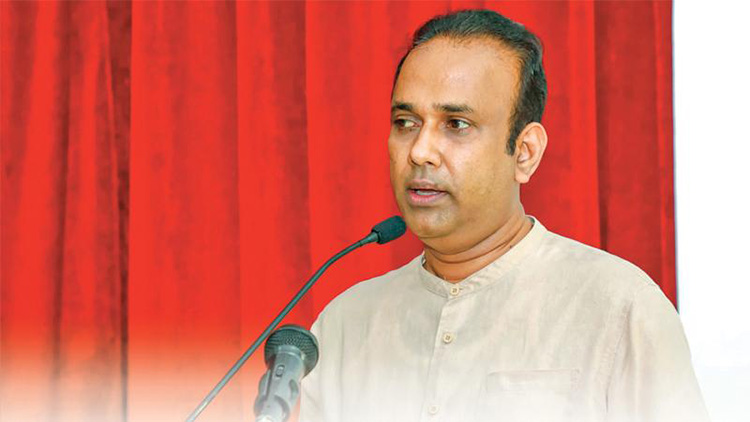
by Dr Gotabhya Ranasinghe
Senior Consultant Cardiologist
National Hospital Sri Lanka
When we sought a meeting with Hon Dr. Ramesh Pathirana, Minister of Health, he graciously cleared his busy schedule to accommodate us. Renowned for his attentive listening and deep understanding, Minister Pathirana is dedicated to advancing the health sector. His openness and transparency exemplify the qualities of an exemplary politician and minister.
Dr. Palitha Mahipala, the current Health Secretary, demonstrates both commendable enthusiasm and unwavering support. This combination of attributes makes him a highly compatible colleague for the esteemed Minister of Health.
Our discussion centered on a project that has been in the works for the past 30 years, one that no other minister had managed to advance.
Minister Pathirana, however, recognized the project’s significance and its potential to revolutionize care for heart patients.
The project involves the construction of a state-of-the-art facility at the premises of the National Hospital Colombo. The project’s location within the premises of the National Hospital underscores its importance and relevance to the healthcare infrastructure of the nation.
This facility will include a cardiology building and a tertiary care center, equipped with the latest technology to handle and treat all types of heart-related conditions and surgeries.
Securing funding was a major milestone for this initiative. Minister Pathirana successfully obtained approval for a $40 billion loan from the Asian Development Bank. With the funding in place, the foundation stone is scheduled to be laid in September this year, and construction will begin in January 2025.
This project guarantees a consistent and uninterrupted supply of stents and related medications for heart patients. As a result, patients will have timely access to essential medical supplies during their treatment and recovery. By securing these critical resources, the project aims to enhance patient outcomes, minimize treatment delays, and maintain the highest standards of cardiac care.
Upon its fruition, this monumental building will serve as a beacon of hope and healing, symbolizing the unwavering dedication to improving patient outcomes and fostering a healthier society.We anticipate a future marked by significant progress and positive outcomes in Sri Lanka’s cardiovascular treatment landscape within the foreseeable timeframe.
Features
A LOVING TRIBUTE TO JESUIT FR. ALOYSIUS PIERIS ON HIS 90th BIRTHDAY

by Fr. Emmanuel Fernando, OMI
Jesuit Fr. Aloysius Pieris (affectionately called Fr. Aloy) celebrated his 90th birthday on April 9, 2024 and I, as the editor of our Oblate Journal, THE MISSIONARY OBLATE had gone to press by that time. Immediately I decided to publish an article, appreciating the untiring selfless services he continues to offer for inter-Faith dialogue, the renewal of the Catholic Church, his concern for the poor and the suffering Sri Lankan masses and to me, the present writer.
It was in 1988, when I was appointed Director of the Oblate Scholastics at Ampitiya by the then Oblate Provincial Fr. Anselm Silva, that I came to know Fr. Aloy more closely. Knowing well his expertise in matters spiritual, theological, Indological and pastoral, and with the collaborative spirit of my companion-formators, our Oblate Scholastics were sent to Tulana, the Research and Encounter Centre, Kelaniya, of which he is the Founder-Director, for ‘exposure-programmes’ on matters spiritual, biblical, theological and pastoral. Some of these dimensions according to my view and that of my companion-formators, were not available at the National Seminary, Ampitiya.
Ever since that time, our Oblate formators/ accompaniers at the Oblate Scholasticate, Ampitiya , have continued to send our Oblate Scholastics to Tulana Centre for deepening their insights and convictions regarding matters needed to serve the people in today’s context. Fr. Aloy also had tried very enthusiastically with the Oblate team headed by Frs. Oswald Firth and Clement Waidyasekara to begin a Theologate, directed by the Religious Congregations in Sri Lanka, for the contextual formation/ accompaniment of their members. It should very well be a desired goal of the Leaders / Provincials of the Religious Congregations.
Besides being a formator/accompanier at the Oblate Scholasticate, I was entrusted also with the task of editing and publishing our Oblate journal, ‘The Missionary Oblate’. To maintain the quality of the journal I continue to depend on Fr. Aloy for his thought-provoking and stimulating articles on Biblical Spirituality, Biblical Theology and Ecclesiology. I am very grateful to him for his generous assistance. Of late, his writings on renewal of the Church, initiated by Pope St. John XX111 and continued by Pope Francis through the Synodal path, published in our Oblate journal, enable our readers to focus their attention also on the needed renewal in the Catholic Church in Sri Lanka. Fr. Aloy appreciated very much the Synodal path adopted by the Jesuit Pope Francis for the renewal of the Church, rooted very much on prayerful discernment. In my Religious and presbyteral life, Fr.Aloy continues to be my spiritual animator / guide and ongoing formator / acccompanier.
Fr. Aloysius Pieris, BA Hons (Lond), LPh (SHC, India), STL (PFT, Naples), PhD (SLU/VC), ThD (Tilburg), D.Ltt (KU), has been one of the eminent Asian theologians well recognized internationally and one who has lectured and held visiting chairs in many universities both in the West and in the East. Many members of Religious Congregations from Asian countries have benefited from his lectures and guidance in the East Asian Pastoral Institute (EAPI) in Manila, Philippines. He had been a Theologian consulted by the Federation of Asian Bishops’ Conferences for many years. During his professorship at the Gregorian University in Rome, he was called to be a member of a special group of advisers on other religions consulted by Pope Paul VI.
Fr. Aloy is the author of more than 30 books and well over 500 Research Papers. Some of his books and articles have been translated and published in several countries. Among those books, one can find the following: 1) The Genesis of an Asian Theology of Liberation (An Autobiographical Excursus on the Art of Theologising in Asia, 2) An Asian Theology of Liberation, 3) Providential Timeliness of Vatican 11 (a long-overdue halt to a scandalous millennium, 4) Give Vatican 11 a chance, 5) Leadership in the Church, 6) Relishing our faith in working for justice (Themes for study and discussion), 7) A Message meant mainly, not exclusively for Jesuits (Background information necessary for helping Francis renew the Church), 8) Lent in Lanka (Reflections and Resolutions, 9) Love meets wisdom (A Christian Experience of Buddhism, 10) Fire and Water 11) God’s Reign for God’s poor, 12) Our Unhiddden Agenda (How we Jesuits work, pray and form our men). He is also the Editor of two journals, Vagdevi, Journal of Religious Reflection and Dialogue, New Series.
Fr. Aloy has a BA in Pali and Sanskrit from the University of London and a Ph.D in Buddhist Philosophy from the University of Sri Lankan, Vidyodaya Campus. On Nov. 23, 2019, he was awarded the prestigious honorary Doctorate of Literature (D.Litt) by the Chancellor of the University of Kelaniya, the Most Venerable Welamitiyawe Dharmakirthi Sri Kusala Dhamma Thera.
Fr. Aloy continues to be a promoter of Gospel values and virtues. Justice as a constitutive dimension of love and social concern for the downtrodden masses are very much noted in his life and work. He had very much appreciated the commitment of the late Fr. Joseph (Joe) Fernando, the National Director of the Social and Economic Centre (SEDEC) for the poor.
In Sri Lanka, a few religious Congregations – the Good Shepherd Sisters, the Christian Brothers, the Marist Brothers and the Oblates – have invited him to animate their members especially during their Provincial Congresses, Chapters and International Conferences. The mainline Christian Churches also have sought his advice and followed his seminars. I, for one, regret very much, that the Sri Lankan authorities of the Catholic Church –today’s Hierarchy—- have not sought Fr.
Aloy’s expertise for the renewal of the Catholic Church in Sri Lanka and thus have not benefited from the immense store of wisdom and insight that he can offer to our local Church while the Sri Lankan bishops who governed the Catholic church in the immediate aftermath of the Second Vatican Council (Edmund Fernando OMI, Anthony de Saram, Leo Nanayakkara OSB, Frank Marcus Fernando, Paul Perera,) visited him and consulted him on many matters. Among the Tamil Bishops, Bishop Rayappu Joseph was keeping close contact with him and Bishop J. Deogupillai hosted him and his team visiting him after the horrible Black July massacre of Tamils.
Features
A fairy tale, success or debacle
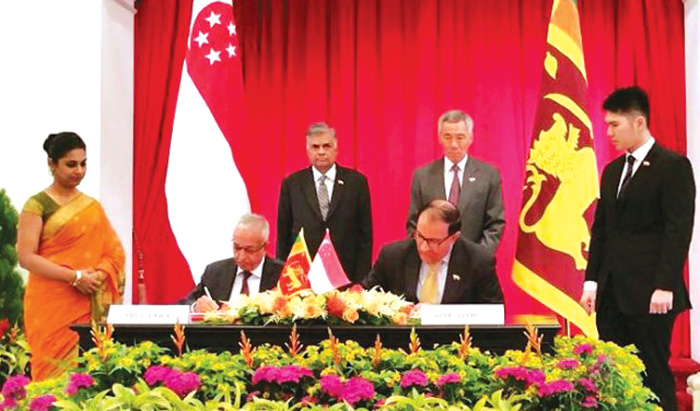
Sri Lanka-Singapore Free Trade Agreement
By Gomi Senadhira
senadhiragomi@gmail.com
“You might tell fairy tales, but the progress of a country cannot be achieved through such narratives. A country cannot be developed by making false promises. The country moved backward because of the electoral promises made by political parties throughout time. We have witnessed that the ultimate result of this is the country becoming bankrupt. Unfortunately, many segments of the population have not come to realize this yet.” – President Ranil Wickremesinghe, 2024 Budget speech
Any Sri Lankan would agree with the above words of President Wickremesinghe on the false promises our politicians and officials make and the fairy tales they narrate which bankrupted this country. So, to understand this, let’s look at one such fairy tale with lots of false promises; Ranil Wickremesinghe’s greatest achievement in the area of international trade and investment promotion during the Yahapalana period, Sri Lanka-Singapore Free Trade Agreement (SLSFTA).
It is appropriate and timely to do it now as Finance Minister Wickremesinghe has just presented to parliament a bill on the National Policy on Economic Transformation which includes the establishment of an Office for International Trade and the Sri Lanka Institute of Economics and International Trade.
Was SLSFTA a “Cleverly negotiated Free Trade Agreement” as stated by the (former) Minister of Development Strategies and International Trade Malik Samarawickrama during the Parliamentary Debate on the SLSFTA in July 2018, or a colossal blunder covered up with lies, false promises, and fairy tales? After SLSFTA was signed there were a number of fairy tales published on this agreement by the Ministry of Development Strategies and International, Institute of Policy Studies, and others.
However, for this article, I would like to limit my comments to the speech by Minister Samarawickrama during the Parliamentary Debate, and the two most important areas in the agreement which were covered up with lies, fairy tales, and false promises, namely: revenue loss for Sri Lanka and Investment from Singapore. On the other important area, “Waste products dumping” I do not want to comment here as I have written extensively on the issue.
1. The revenue loss
During the Parliamentary Debate in July 2018, Minister Samarawickrama stated “…. let me reiterate that this FTA with Singapore has been very cleverly negotiated by us…. The liberalisation programme under this FTA has been carefully designed to have the least impact on domestic industry and revenue collection. We have included all revenue sensitive items in the negative list of items which will not be subject to removal of tariff. Therefore, 97.8% revenue from Customs duty is protected. Our tariff liberalisation will take place over a period of 12-15 years! In fact, the revenue earned through tariffs on goods imported from Singapore last year was Rs. 35 billion.
The revenue loss for over the next 15 years due to the FTA is only Rs. 733 million– which when annualised, on average, is just Rs. 51 million. That is just 0.14% per year! So anyone who claims the Singapore FTA causes revenue loss to the Government cannot do basic arithmetic! Mr. Speaker, in conclusion, I call on my fellow members of this House – don’t mislead the public with baseless criticism that is not grounded in facts. Don’t look at petty politics and use these issues for your own political survival.”
I was surprised to read the minister’s speech because an article published in January 2018 in “The Straits Times“, based on information released by the Singaporean Negotiators stated, “…. With the FTA, tariff savings for Singapore exports are estimated to hit $10 million annually“.
As the annual tariff savings (that is the revenue loss for Sri Lanka) calculated by the Singaporean Negotiators, Singaporean $ 10 million (Sri Lankan rupees 1,200 million in 2018) was way above the rupees’ 733 million revenue loss for 15 years estimated by the Sri Lankan negotiators, it was clear to any observer that one of the parties to the agreement had not done the basic arithmetic!
Six years later, according to a report published by “The Morning” newspaper, speaking at the Committee on Public Finance (COPF) on 7th May 2024, Mr Samarawickrama’s chief trade negotiator K.J. Weerasinghehad had admitted “…. that forecasted revenue loss for the Government of Sri Lanka through the Singapore FTA is Rs. 450 million in 2023 and Rs. 1.3 billion in 2024.”
If these numbers are correct, as tariff liberalisation under the SLSFTA has just started, we will pass Rs 2 billion very soon. Then, the question is how Sri Lanka’s trade negotiators made such a colossal blunder. Didn’t they do their basic arithmetic? If they didn’t know how to do basic arithmetic they should have at least done their basic readings. For example, the headline of the article published in The Straits Times in January 2018 was “Singapore, Sri Lanka sign FTA, annual savings of $10m expected”.
Anyway, as Sri Lanka’s chief negotiator reiterated at the COPF meeting that “…. since 99% of the tariffs in Singapore have zero rates of duty, Sri Lanka has agreed on 80% tariff liberalisation over a period of 15 years while expecting Singapore investments to address the imbalance in trade,” let’s turn towards investment.
Investment from Singapore
In July 2018, speaking during the Parliamentary Debate on the FTA this is what Minister Malik Samarawickrama stated on investment from Singapore, “Already, thanks to this FTA, in just the past two-and-a-half months since the agreement came into effect we have received a proposal from Singapore for investment amounting to $ 14.8 billion in an oil refinery for export of petroleum products. In addition, we have proposals for a steel manufacturing plant for exports ($ 1 billion investment), flour milling plant ($ 50 million), sugar refinery ($ 200 million). This adds up to more than $ 16.05 billion in the pipeline on these projects alone.
And all of these projects will create thousands of more jobs for our people. In principle approval has already been granted by the BOI and the investors are awaiting the release of land the environmental approvals to commence the project.
I request the Opposition and those with vested interests to change their narrow-minded thinking and join us to develop our country. We must always look at what is best for the whole community, not just the few who may oppose. We owe it to our people to courageously take decisions that will change their lives for the better.”
According to the media report I quoted earlier, speaking at the Committee on Public Finance (COPF) Chief Negotiator Weerasinghe has admitted that Sri Lanka was not happy with overall Singapore investments that have come in the past few years in return for the trade liberalisation under the Singapore-Sri Lanka Free Trade Agreement. He has added that between 2021 and 2023 the total investment from Singapore had been around $162 million!
What happened to those projects worth $16 billion negotiated, thanks to the SLSFTA, in just the two-and-a-half months after the agreement came into effect and approved by the BOI? I do not know about the steel manufacturing plant for exports ($ 1 billion investment), flour milling plant ($ 50 million) and sugar refinery ($ 200 million).
However, story of the multibillion-dollar investment in the Petroleum Refinery unfolded in a manner that would qualify it as the best fairy tale with false promises presented by our politicians and the officials, prior to 2019 elections.
Though many Sri Lankans got to know, through the media which repeatedly highlighted a plethora of issues surrounding the project and the questionable credentials of the Singaporean investor, the construction work on the Mirrijiwela Oil Refinery along with the cement factory began on the24th of March 2019 with a bang and Minister Ranil Wickremesinghe and his ministers along with the foreign and local dignitaries laid the foundation stones.
That was few months before the 2019 Presidential elections. Inaugurating the construction work Prime Minister Ranil Wickremesinghe said the projects will create thousands of job opportunities in the area and surrounding districts.
The oil refinery, which was to be built over 200 acres of land, with the capacity to refine 200,000 barrels of crude oil per day, was to generate US$7 billion of exports and create 1,500 direct and 3,000 indirect jobs. The construction of the refinery was to be completed in 44 months. Four years later, in August 2023 the Cabinet of Ministers approved the proposal presented by President Ranil Wickremesinghe to cancel the agreement with the investors of the refinery as the project has not been implemented! Can they explain to the country how much money was wasted to produce that fairy tale?
It is obvious that the President, ministers, and officials had made huge blunders and had deliberately misled the public and the parliament on the revenue loss and potential investment from SLSFTA with fairy tales and false promises.
As the president himself said, a country cannot be developed by making false promises or with fairy tales and these false promises and fairy tales had bankrupted the country. “Unfortunately, many segments of the population have not come to realize this yet”.
(The writer, a specialist and an activist on trade and development issues . )


